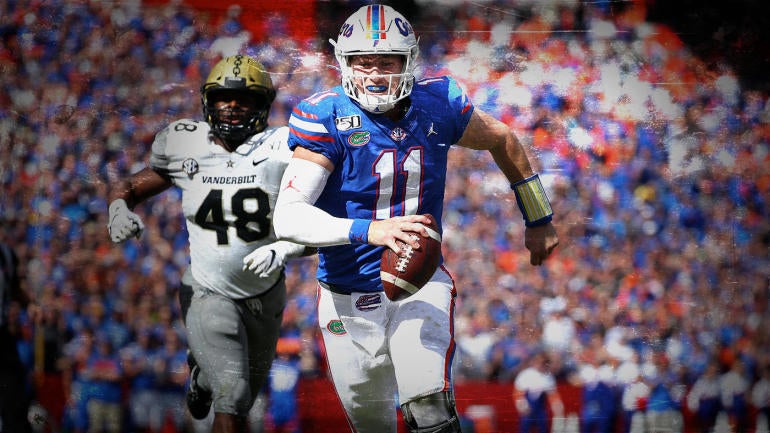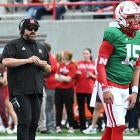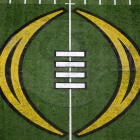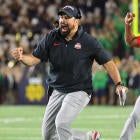
The College Football Playoff is entering its seventh season, and even with a small sample size, we've already hit some benchmarks that can help shape our expectations for future postseasons. Teams can make the playoff without winning their conference, for example, and there is no limit on the number of teams from one conference as we saw both Alabama and SEC champion Georgia not only make the final four in 2017 but then face off for an epic national title game. Notre Dame does not need to be a full conference member or play for a conference championship to make the College Football Playoff, as we saw in 2018, and it is possible to hold the playoffs without including Alabama, which happened for the first time ever in 2019.
One interesting wrinkle to the first six seasons of the College Football Playoff has been that each year has featured at least one rookie in the four-team field. Last season, it was LSU, who clearly did not see its playoff inexperience as a hindering factor as it lit up the scoreboard on the way to a national championship, joining a group of playoff regulars in Clemson, Ohio State and Oklahoma. In the six years of the playoff, only Alabama (5), Clemson (5), Oklahoma (4) and Ohio State (3) have multiple appearances. At some point, we're bound to see a playoff of nothing but returning customers, but the absence of the Big Ten and Pac-12 from the fall 2020 season has seemingly opened the door for a continuation of this early playoff era trend.
Alabama, Clemson and Oklahoma are going to be popular picks to make the playoff again, and the likes of Georgia and Notre Dame add to the possibility that the club is not accepting new members in 2020. Even LSU and Florida State, the former reloading after a mass exodus of talent from last year's title team and the latter laying the foundations in year one with Mike Norvell, could potentially bring an end to this trend if they were to overwhelmingly exceed preseason expectations. But outside of those seven teams stands 69 more FBS programs looking to finish in the top four of the CFP Rankings when the committee reveals the semifinal matchups on Dec. 20.
Among those teams, we've picked seven potential options to be playoff first-timers in 2020 and ranked them in terms of likelihood. We begin our rundown with a team looking to reclaim a level of national championship contention that's been missing for more than a decade.
1. Florida
There's an argument for Kyle Trask as the best quarterback in the SEC and Dan Mullen as one of the top coaches not only in the league but in the country. Trask has expectations that weren't there when Feleipe Franks started the season in 2019, and the Gators are no longer finding their footing with Mullen but now expected to compete for the SEC title after back-to-back New Year's Six bowl wins and postseason top-10 finishes. The 10-game schedule handed to the Gators sets up well for another strong season with two games likely to determine their playoff contention: at Texas A&M on Oct. 10 and the crucial SEC East-deciding Florida-Georgia game on Nov. 7. Now, it's possible that there is an Alabama-in-2017 kind of path for Florida that would include losing the regular season date to Georgia and still making the playoff by winning every other game, but the easiest way to keep your playoff odds favorable is to have that quality win and a shot at the SEC championship with the committee tuned in looking to make its final decisions.
2. Texas
Like Florida, Texas is trying to live the dream of the 2000s after a decade in the wilderness. Oklahoma has been the most dominant Big 12 program not just in the playoff era but for the league's entire existence, yet any whiff of Texas potentially returning to title contention has us doing the "back" dance even though "back" has no defined target or well-entrenched set of expectations. But without a doubt, the conversations start with Oklahoma and the need not just to win the rivalry game (something Tom Herman has done) but also take care of business against the rest of the league (something Herman has not done). The Longhorns are 17-10 in Big 12 play over the last three years, and if Texas is going to make the CFP, it has to avoid bad losses. The Longhorns have fallen to an unranked conference opponent in each of Herman's three years in Austin, Texas, and it's those losses -- not necessarily one to Oklahoma -- that have to be eliminated in order for Texas to take the next step. Forget about "back." For Texas, it should be all about "forward."
T3. Texas A&M, Auburn
These next two are tied because they share the same kind of path to the playoff but have not, in my opinion, provided overwhelming evidence to support one team over the other in terms of likelihood. For the Aggies, the cause for optimism in 2020 comes from an acknowledgement that the talent level has been raised by Jimbo Fisher and here in Year 3 is where we should start to see some on-field payoff. Texas A&M made Bud Elliott's Blue Chip Ratio list -- signing more four-star and five-star prospects than non over a four-class cycle -- for the first time four years, and there's enough buzz around DeMarvin Leal and some of the sophomores from that top-five 2019 class to think the talent will be showing up on the field in a big way. There key to making the playoff is beating Alabama and/or winning the SEC West, which in turn comes back to the question of whether Kellen Mond is a championship-caliber quarterback. If he proves to be, then Jimbo could become the first coach to lead two different teams to the CFP.
The key for Auburn remains beating Alabama and/or winning the SEC West, and since Gus Malzahn has done both already, there is at least the foundation laid for a playoff run. Bo Nix enters Year 2 -- now with Chad Morris as the offensive coordinator -- in one of the most fascinating SEC storylines of the season. The Tigers have an elite pair of wide receivers with Seth Williams and Anthony Schwartz along with a deep backfield of good options at running back, but the offensive line is a major concern. There's only so much that Malzahn and Morris can do to scheme around weak line play, and the schedule includes some of the best defensive fronts in the country with Georgia, Alabama and Texas A&M. Auburn should be solid on defense again and elite at the linebacker position in particular, but a playoff run hinges on how effective that offense is going to be against the best teams in the SEC.
5. Oklahoma State
The Cowboys have more returning production than anyone else in the Big 12 and one of the best quarterback-running back-wide receiver trios in the country with Spencer Sanders, Chuba Hubbard and Tylan Wallace. Hype for the Cowboys in 2020 has been all over the map with stock soaring when Hubbard announced his return, wavering as Gundy's treatment towards the team was being investigated by the athletic director and now returning to light hum as we get set to start the season. It's maybe Gundy's best team since 2011, and he's going to need a 2011-like performance if Oklahoma State is going to make the CFP. Any hesitation for moving the Cowboys into the playoff picture comes from its history against league opponents, losing at least two conference games every years but one (2011) since Gundy arrived in 2005. There have been four 10-win seasons since 2013, but each was matched with a 7-2 showing in conference play. To make the playoff, Oklahoma State can't afford two losses. If his best team since 2011 has a 2011-like year, then instead of being left out by the BCS formula, they'll have the chance they wanted then to compete for a title on the field in the playoff.
6. North Carolina
Clemson clearly holds not just the preseason expectations of a playoff return but also the overwhelming odds to win the ACC for a sixth straight season. Notre Dame could stand in its way, but even if the Irish make the playoff, we're talking about a second appearance and not an extension of the first-timer trend. So when scanning the ACC for a potential first-timer, the focus narrows on what should be among the most prolific offenses in the country at North Carolina. Mack Brown hired Phil Longo to install a balanced and aggressive attack, flipped Sam Howell from Florida State and then let the freshman loose in 2019. More than 3,600 passing yards and 38 passing touchdowns later, Howell is ready to lead UNC into conference title contention with two 1,000-yard receivers and a 1,000-yard rusher all back to help with the effort. North Carolina gets a late-season shot hosting Notre Dame on Nov. 27 and avoids Clemson on its 10-game ACC slate, but actually making the playoff will probably require dethroning the Tigers in Charlotte for the conference championship. Even in the "two ACC teams in the playoff" scenario, North Carolina needs to have wins against Notre Dame, Florida State, Miami and Virginia Tech while avoiding any bad losses. The Tar Heels seem like the most likely non-Clemson, non-Notre Dame team to make the playoff, but that kind of consistency is big step up for a team that went 4-4 in ACC play a year ago.
7. UCF
While already deemed national champions by the Colley Matrix in 2017 after going 13-0, the Knights are really looking for respect from the CFP Selection Committee and a fair shake at the title on the field as one of the top four teams in the final rankings. While the absence of Ohio State, Penn State and Oregon seemingly provide more of an opportunity for a conference to get two teams into the playoff, the same potential is there for a higher ranking of a Group of Five champion. The Knights are not only the favorites to win the AAC but have two things in their favor when it comes to impressing the committee. First, Dillon Gabriel and the high-powered Knights offense has the potential to put up scores and margins of victory that will be impossible to ignore on the basis of schedule strength. To make the top four, UCF will not only need an unbeaten record but the kind of results that make all of college football yearn for a showdown against the best of the SEC, ACC or Big 12. The other factor for UCF is the established standard of success from winning 35 games over the last three seasons. The committee is only supposed to rank teams based on one year's performance, but there's a subconscious edge to being the program that's been knocking on the door with two New Year's Six appearances. That familiarity can help power a rise in the rankings, but it fades quickly if UCF doesn't have a zero in the loss column.





















